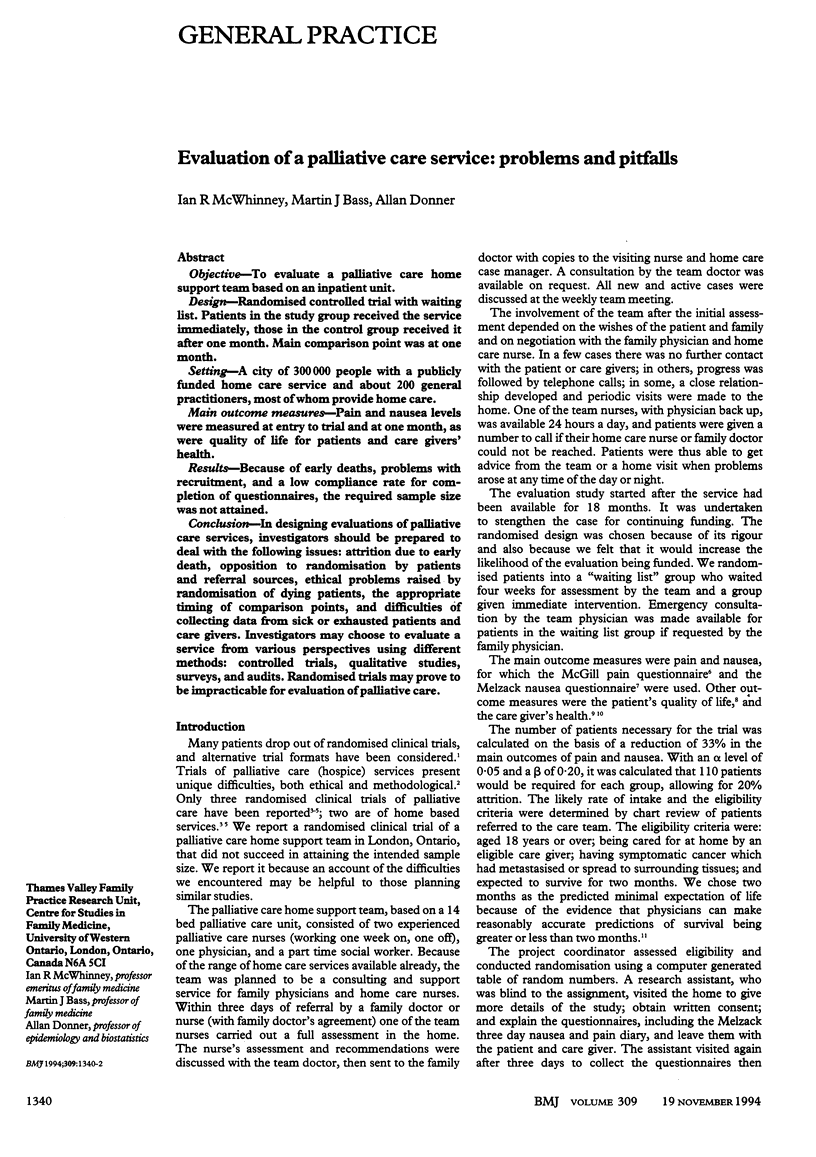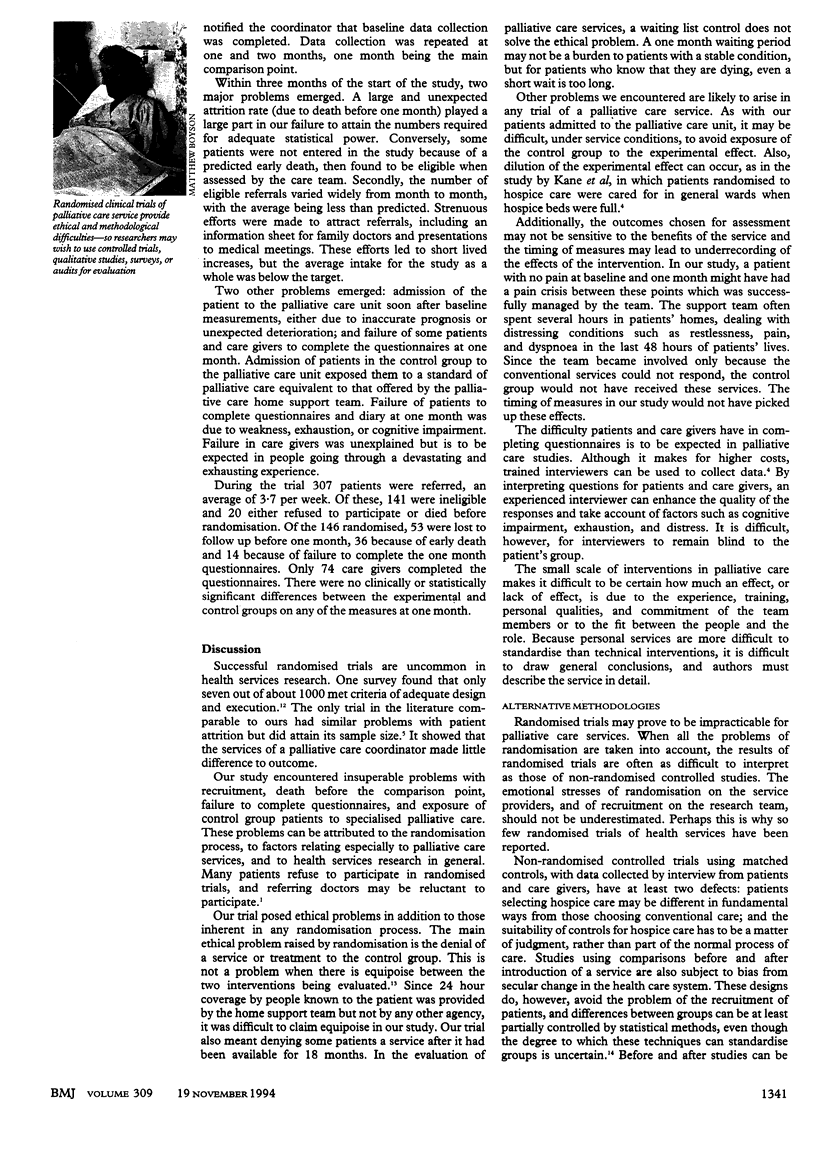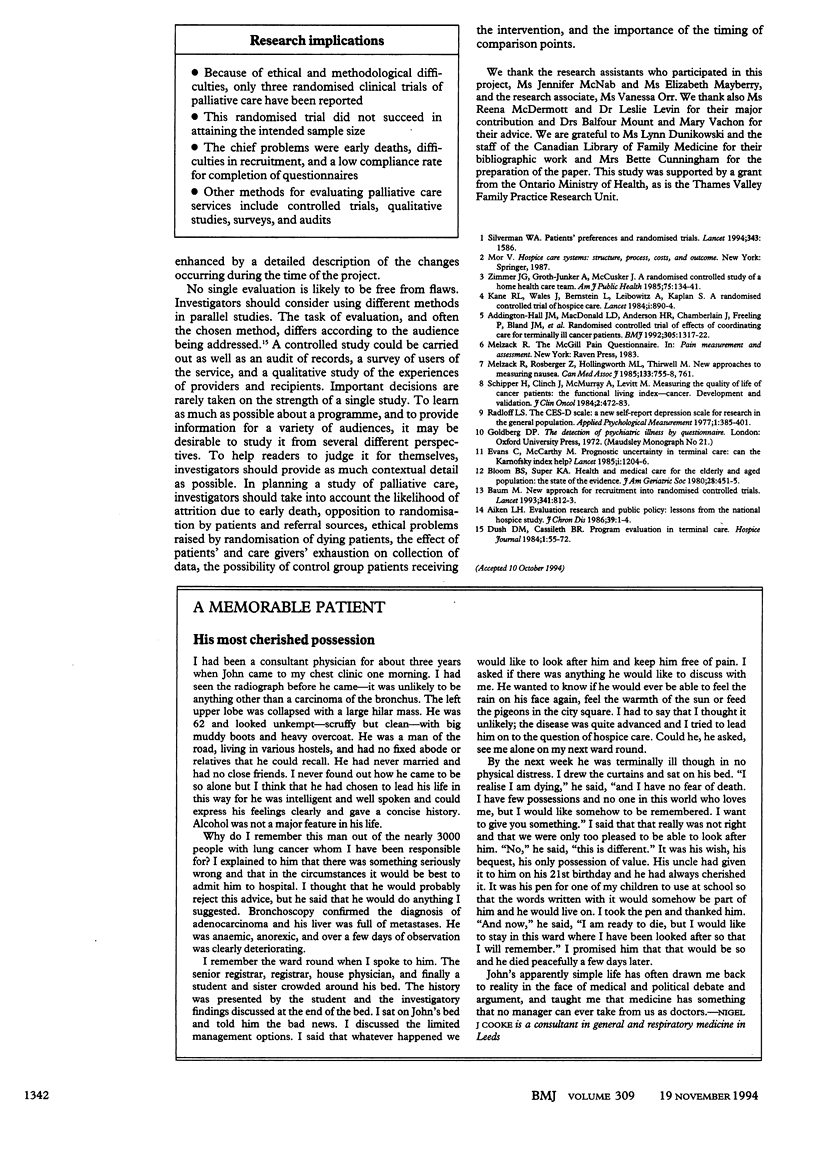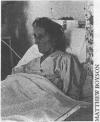Abstract
OBJECTIVE--To evaluate a palliative care home support team based on an inpatient unit. DESIGN--Randomised controlled trial with waiting list. Patients in the study group received the service immediately, those in the control group received it after one month. Main comparison point was at one month. SETTING--A city of 300,000 people with a publicly funded home care service and about 200 general practitioners, most of whom provide home care. MAIN OUTCOME MEASURES--Pain and nausea levels were measured at entry to trial and at one month, as were quality of life for patients and care givers' health. RESULTS--Because of early deaths, problems with recruitment, and a low compliance rate for completion of questionnaires, the required sample size was not attained. CONCLUSION--In designing evaluations of palliative care services, investigators should be prepared to deal with the following issues: attrition due to early death, opposition to randomisation by patients and referral sources, ethical problems raised by randomisation of dying patients, the appropriate timing of comparison points, and difficulties of collecting data from sick or exhausted patients and care givers. Investigators may choose to evaluate a service from various perspectives using different methods: controlled trials, qualitative studies, surveys, and audits. Randomised trials may prove to be impracticable for evaluation of palliative care.
Full text
PDF


Images in this article
Selected References
These references are in PubMed. This may not be the complete list of references from this article.
- Addington-Hall J. M., MacDonald L. D., Anderson H. R., Chamberlain J., Freeling P., Bland J. M., Raftery J. Randomised controlled trial of effects of coordinating care for terminally ill cancer patients. BMJ. 1992 Nov 28;305(6865):1317–1322. doi: 10.1136/bmj.305.6865.1317. [DOI] [PMC free article] [PubMed] [Google Scholar]
- Aiken L. H. Evaluation research and public policy: lessons from the National Hospice Study. J Chronic Dis. 1986;39(1):1–4. doi: 10.1016/0021-9681(86)90101-3. [DOI] [PubMed] [Google Scholar]
- Baum M. New approach for recruitment into randomised controlled trials. Lancet. 1993 Mar 27;341(8848):812–813. doi: 10.1016/0140-6736(93)90573-y. [DOI] [PubMed] [Google Scholar]
- Bloom B. S., Soper K. A. Health and medical care for the elderly and aged population: the state of the evidence. J Am Geriatr Soc. 1980 Oct;28(10):451–455. doi: 10.1111/j.1532-5415.1980.tb01118.x. [DOI] [PubMed] [Google Scholar]
- Dush D. M., Cassileth B. R. Program evaluation in terminal care. Hosp J. 1985 Spring;1(1):55–72. doi: 10.1080/0742-969x.1985.11882519. [DOI] [PubMed] [Google Scholar]
- Evans C., McCarthy M. Prognostic uncertainty in terminal care: can the Karnofsky index help? Lancet. 1985 May 25;1(8439):1204–1206. doi: 10.1016/s0140-6736(85)92876-4. [DOI] [PubMed] [Google Scholar]
- Kane R. L., Wales J., Bernstein L., Leibowitz A., Kaplan S. A randomised controlled trial of hospice care. Lancet. 1984 Apr 21;1(8382):890–894. doi: 10.1016/s0140-6736(84)91349-7. [DOI] [PubMed] [Google Scholar]
- Melzack R., Rosberger Z., Hollingsworth M. L., Thirlwell M. New approaches to measuring nausea. CMAJ. 1985 Oct 15;133(8):755-8, 761. [PMC free article] [PubMed] [Google Scholar]
- Schipper H., Clinch J., McMurray A., Levitt M. Measuring the quality of life of cancer patients: the Functional Living Index-Cancer: development and validation. J Clin Oncol. 1984 May;2(5):472–483. doi: 10.1200/JCO.1984.2.5.472. [DOI] [PubMed] [Google Scholar]
- Silverman W. A. Patients' preferences and randomised trials. Lancet. 1994 Jun 25;343(8913):1586–1586. doi: 10.1016/s0140-6736(94)93053-8. [DOI] [PubMed] [Google Scholar]
- Zimmer J. G., Groth-Juncker A., McCusker J. A randomized controlled study of a home health care team. Am J Public Health. 1985 Feb;75(2):134–141. doi: 10.2105/ajph.75.2.134. [DOI] [PMC free article] [PubMed] [Google Scholar]



